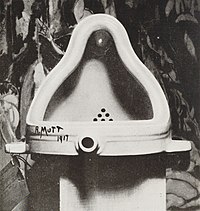Conceptual art

Conceptual art is art in which the concepts or ideas involved in the work are more important than traditional aesthetic and material concerns. Many of the works, sometimes called installations, may be constructed by anyone simply by following a set of written instructions.[1] This method was fundamental to one of the first to appear in print:
- "In conceptual art the idea or concept is the most important aspect of the work. When an artist uses a conceptual form of art, it means that all of the planning and decisions are made beforehand and the execution is a perfunctory affair. The idea becomes a machine that makes the art".[2]
Conceptual art even questions the nature of art.[3] Joseph Kosuth elevated this into a definition of art itself in his early manifesto of conceptual art.[4]
The notion that art should examine its own nature was already part of art critic Clement Greenberg's vision of modern art during the 1950s. With the emergence of an exclusively language-based art in the 1960s, however, conceptual artists began a far more radical analysis of art than was previously done. One of the first things they questioned was the assumption that the role of the artist was to create special kinds of material objects.[4][5][6]
Conceptual art has come to mean all contemporary art which does not use the traditional skills of painting and sculpture.[7]
Related pages[change | change source]
References[change | change source]
- ↑ "Facsimile of original instructions for Wall Drawing 811 by Phil Gleason, with a view of the installed work at Franklin Furnace. October 1996". Archived from the original on 2007-03-02. Retrieved 2010-11-13.
- ↑ Sol LeWitt 1967. "Paragraphs on Conceptual Art". Artforum, June.
- ↑ Tony Godfrey 1998. Conceptual Art. London.
- ↑ 4.0 4.1 Joseph Kosuth 1969. "Art After Philosophy". Reprinted in Peter Osborne (ed) 2002. Conceptual Art: themes and movements. Phaidon, London. p232
- ↑ Art & Language, Art-Language (journal): Introduction 1969. Reprinted in Osborne 2002 p230
- ↑ Ian Burn, Mel Ramsden 1970. "Notes On Analysis" (1970). Reprinted in Osborne 2002, p237. e.g. "The outcome of much of the 'conceptual' work of the past two years has been to carefully clear the air of objects".
- ↑ Turner prize history: Conceptual art Tate gallery tate.org.uk. Accessed August 8, 2006
